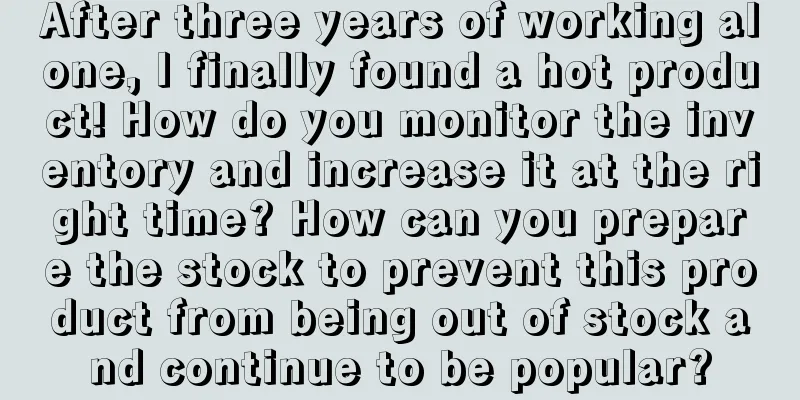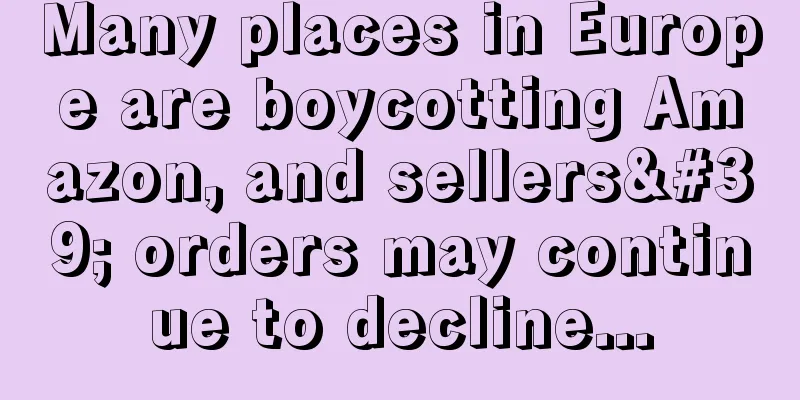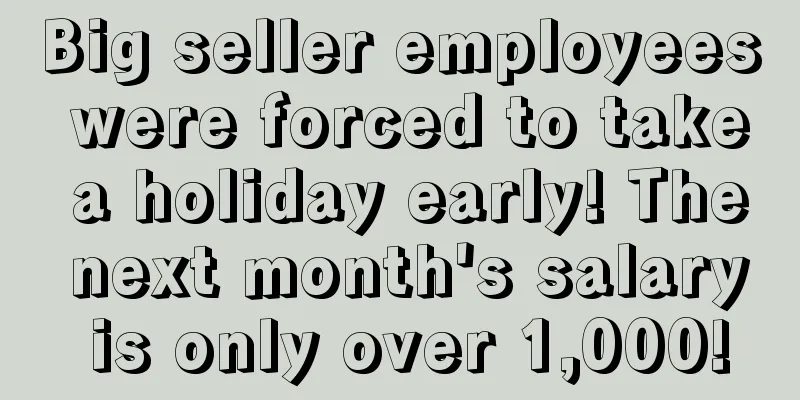|
Let me start with the background: I finally had a hit product this year, with daily sales from single digits to double digits (please allow me to call it a hit product). But the problem came quietly. The product was put on the shelves in April, with 500 pieces in stock . In July, sales suddenly jumped from single digits to double digits, and it was out of stock for the first time. I replenished 1,000 sets, shipped on August 5, arrived in September, and started to sell on October 19. There was a signal of out of stock, so I replenished 1,500 sets. It was the peak season, and all kinds of warehouses and configuration fees were charged, so I shipped them out with tears.
During this process, competing products continued to emerge and took up my sales. The time advantage accumulated before no longer existed, and I began to worry about the rhythm of future operations. Therefore, in line with the principle of learning from the false to cultivate the true, and previous mistakes are the experience for the future, I have the following thoughts on [starting to stock up]:
For a product, the sales volume increases first, but then it is out of stock. How can we reasonably estimate the sales volume, how can we reasonably prepare the stock at a safe time, and how can we monitor and issue alerts on sales volume?
- Based on the principle of [only allowing out-of-stock once], when out-of-stock for the first time, stock up based on the highest average daily sales before the out-of-stock, combined with the peak season trend and the rising trend; for example, if the highest average daily sales in a week before the first out-of-stock is 15, then stock up based on an average daily sales of 15.
This leads to question 1: When it was the July Member Day, I was worried that if I based my daily average sales on the stock, I would have to stock up too much and occupy funds. But then again, if the new link can sell 15 units per day, then it has an upward trend and needs a certain amount of volume. How do you generally estimate the second stocking?
- [Stock enough for 4 months] The stock quantity is calculated based on 4 months, that is, 15*120 days=1800 pieces. In the first month, observe whether there is an incremental trend, observe the average daily sales, and be prepared to increase the quantity at any time.
This leads to question 2: If you prepare four months' worth of stock at once, it would be a risky move for a new product that is out of stock the first time. Generally, how many months do people prepare the second time?
- [How to set safety stock] For new products with an average of 15 pieces per day and a growing trend, how to set safety stock? My solution is to calculate the incremental rolling 8-week inventory as safety stock and monitor it weekly. This leads to question 3: How do you monitor inventory and increase it in time?
- [How to solve the problem of stocking cycle involving peak season] Can we make a forecast based on - 2 times the peak season - sales? Because it involves stocking for the peak season, should the goods arrive before the end of September? Prepare 4 months of supply to cope with the peak season? Is this a risky behavior for new products? This leads to question 4: How do you estimate the sales volume of new products during the peak season? Question 5: Which month do you prepare the goods? Which warehouse is more cost-effective to ship to?
-[Stocking after the peak season] Due to the impact of the peak season, how do you make sales forecasts and stocking estimates after the peak season?
- [Stocking VS Operation Rhythm] Question 7 is an additional question. Is there a fixed rhythm for re-promoting the new product after it is out of stock? Will it be combined with a specific rhythm to stock according to the target quantity? What will happen if the target quantity is not reached?
I hope to discuss the above 7 questions with you.
1. How to estimate the second stocking of new products?
2. How many days does it take to prepare the second batch of goods?
3. How do you monitor inventory and increase it when appropriate?
4. How to estimate the sales volume of new products during the peak season?
5. Which month should I prepare the goods and which warehouse should I ship to for the best cost-effectiveness?
6. How to predict the inventory after the peak season?
Additional: 7. When new products are out of stock and competing products take up market share, what is the general approach to stocking and operating?
Wishing you all a happy barley season! "Wonderful Reply" Stewed frozen tofu Agree with: Fat Fu's dad, I am Ahong, Sgpei0828, Yu Ren Da Da, iliilliliill more » The focus is on sales planning
1. How to estimate the second stocking of new products?
A: All stocking that is out of target is based on feelings, and as long as it is based on feelings, it is inaccurate. How much to stock the second time depends on whether the sales data of the first batch of goods reaches your expected target. When we launch a product, generally speaking, the first batch of goods is a test. During the test stage, our approach is to run it freely to know how many orders this product sells per day at the current stage (full advertising + ok conversion rate).
So let it run out of stock for the first time. Stock out is inevitable. For the first batch of goods, you should try to predict what ranking the product will reach after more reviews and higher quality. You can refer to competing products in the same category. In addition, whether the product is a hot product or a seasonal product. If so, the goal is very clear. How much money do you have? Buy it and leave. Get in and out quickly.
If it is a rigid product with clear market demand, you should still estimate sales in the above way. You must have a sales target, and the targets in the testing period and the growth period are different.
2. How many days does it take to prepare the second batch of goods?
After the sales target is set, if the product reaches the target during the testing period, it is very likely to be out of stock. It doesn't matter. From the second stocking, we must ensure the safety of the product inventory. The key factor is the cycle from the order to the FBA to the product being put on the shelf. This is closely related to the scale of the factory and the choice of logistics channels. There is no fixed number of days to prepare. It all depends on your capital and your goals.
Combined with the existing conditions, assuming that it takes 60 days from production to shelf, if you replenish stock every month, then you need to set aside an extra 1-2 months of safety stock each time, that is, always keep 60 days of safety stock in stock plus 30-60 days on the road. In this way, there will basically be no shortage of stock, so 120 days is no problem. 120 days of inventory = 60 days of FBA salable inventory + 30 days of in-transit inventory + 30 days of new order production (optional). The bottom line is 90 days, and this is based on monthly replenishment. Two months of replenishment will require an additional 30 days.
3. How do you monitor inventory and increase it when appropriate ?<br>The sales plan is still the main focus. If the sales volume exceeds the planned volume, you can control the sales volume within a certain range by raising prices, or adjust the sales plan in a timely manner. You need to register the sales volume of products every day so that you can make timely judgments when the trend changes. It is normal for sales to fluctuate, and you cannot adjust the sales plan every time there is a change. Find out the reasons for the sales fluctuations first.
4. How to estimate the sales volume of new products in the peak season <br> Combined with the current ranking of the product, analyze the sales volume changes of the same level of competing products and the overall category in the peak season last year, calculate the growth rate, and substitute it into the daily sales target and sales plan. The key is to first position yourself, how many BS rankings you can get, how much goods you need to sell
5. Which month should I prepare the goods and which warehouse should I ship to for the best cost-effectiveness?
The configuration fee for sub-warehouses is fixed. The other variables depend on which warehouse you can swipe to. You can't just send it to whichever warehouse you want. You can only filter it among the warehouses that you swipe to find a balance between timeliness and price.
6. How to predict the inventory after the peak season?
Same as the answer to the fourth point, I won’t go into details, it’s still a positioning issue
7. When new products are out of stock and competing products occupy market share, what are the general stocking and operation strategies? <br>Competitive products are not afraid of being temporarily surpassed by others. For uncompetitive products, do you need any other strategies besides low-price coupons? If so, tell me so I can learn from you.
Amazon521 1. Conduct market research before launching new products, and pull out the sales volume and sales trends of the products of the top, middle, and bottom sellers in the past year (less than one year from the date of listing to the present).
2. Refer to market competitors, combine your own financial background, benchmark top, middle, or bottom competitors, and combine the general replenishment time (30-60 days) to estimate how many products need to be replenished in the first month to connect to the next batch of products within the general replenishment time. Of course, product testing is not excluded here, but Amazon's warehouse entry time is hard to say. If the test fails, it doesn't matter. If it succeeds but is not replenished in time, it will be out of stock, which is a disadvantage, so early research is important.
3. After the first batch arrives, if there is no problem with the product, and the sales trend and forecast are no problem, and it is steadily increasing, the feedback data given by the product at that time is very important. What position of the product is in the market, whether there is still room for growth, combined with the previous sales trends and sales of competing products near this position as one of the references for replenishment, to prepare for the second batch of replenishment
4. When the product has been selling steadily for more than one year, the new product is basically in a stable position. At this time, you can statistically analyze the sales trend of the product in the past year, and then combine market competition, incremental goals, off-season and peak-season market demand and other factors to make a sales forecast table as a reference for replenishment.
5. As for the freight forwarding issue, it is a timeliness issue, which affects both the market demand and the market competitiveness of the product. We can work backwards. If the product has strong market competitiveness and the market demand trend is rising, we should prepare goods in advance, use slow ships to prepare large quantities of goods, and increase the profit margin. If the product has weak market competitiveness and the market demand trend is falling, we should reduce the stock quantity and use fast ships to replenish small quantities. As for express delivery and air transportation, they are used as emergency measures.
Fighting Buddha Agree from: Wang Jiaer I'd like to give you some conservative advice:
1. How to estimate the second stocking of new products?
New products are generally stocked at 80% of the maximum for two months, 15*60*0.8=720. However, in view of the current warehouse explosion, we can stock one month’s worth of goods in the company and ship them out within one month depending on the situation!
2. How many days does it take to prepare the second batch of goods?
60 days is enough! You can prepare for liquidation in two and a half months, which is 75 days. If you want to participate in various activities, you can add extra days on this basis!
3. How do you monitor inventory and increase it when appropriate?
With the help of Amazon backend inventory management to set thresholds, or third-party ERP, and check manually every day, the goods are ready in the company and ready to go at any time! In this way, the rhythm is dynamic, and you can attack or defend!
4. How to estimate the sales volume of new products during the peak season?
See the data of three or more competitors in the same rank as you!
5. Which month should I prepare the goods and which warehouse should I ship to for the best cost-effectiveness?
It is definitely the off-season, but it depends on the specific situation. There are also freight forwarders holding activities in the peak season! Calculate the comprehensive cost, warehouse fees, etc.!
6. How to predict the inventory after the peak season?
The logic is the same as the fourth one. The best value is 1.2 times your average daily sales in the off-season!
7. When new products are out of stock and competing products take up market share, what is the general stocking and operation strategy?
If out of stock, we will use two methods: air freight and price increase! If the product is selling well, the overseas warehouse will usually keep the product for a month! We are always ready to enter the warehouse immediately and start selling!
Late autumn leaves fall Agree from: alanlvkw, tgm2024, 人间I愁愁客, 兔子87 This is a regular issue of stocking and operation, but the difference is that this is a situation where individual sellers need to be cautious when spending money.
One of the biggest headaches for solo sellers is that their products have poor risk resistance. Once they are targeted by copycat companies or distribution companies (including fine distribution companies), they are basically done for. Because the products you sell cannot have patents and underwriting rights, it is inevitable that they will deteriorate over time. Knowing this requires you to have a sense of risk resistance. At this time, you need to ask three questions: What is the upper limit of your product? What is the upper limit you can achieve? And can you open a private model within your affordable cost?
Stocking is adjusted according to the above contents. If you know the upper limit, you can make a rough estimate. At the same time, you need to estimate the time. For example, if your current rate is 15/day and the upper limit is 20/day, and 15-20 needs to be promoted for 10 days, then prepare according to 20/day. The specific maintenance time can refer to the score and ranking changes of accurate competitors. If there is no accident, just add or subtract weights for normal monthly stocking. It is recommended to combine sea transportation and express delivery by express delivery. There is a compression of profit but the strong flexibility ensures that you have the least amount of unsalable goods. Determine the stability during the sales process and then slowly switch to sea transportation with higher cost performance.
I hope my suggestions can be helpful to you.
Sellers wear sea Regarding the stock quantity, we all know.
Stock quantity = expected sales - inventory Here we have to consider two processes: the quantity that needs to be produced and the quantity for sale; the quantity that needs to be produced is divided into the quantity being produced and the quantity completed (the quantity that can be packaged, labeled and sent to FBA at any time).
The quantity for sales is divided into the quantity in transit and the quantity in stock.
At this point, in order to ensure that there is no shortage of goods, some big guys have summarized the 6336 stocking principles. That is, the quantity for both production and sales processes must be guaranteed for 90 days each.
The quantity to be produced = 60 days (the quantity in production) + 30 days (the quantity completed); the quantity to be sold = 30 days (the quantity in transit) + 60 days (the quantity already in stock and on sale)
The above principles are for reference only. You can make reasonable decisions based on your personal company's situation. If the sales volume is very small, it is not applicable.
2 Tips for Stocking Up
① Don't underestimate sales. When there are special holidays, big promotions or product sales in the same season, sales may quadruple. In addition, doing a good job of data statistics and analysis for the whole year or the whole quarter can provide a certain degree of basis for stocking up for the next year.
② The stock quantity must be more than the actual sales volume to maintain appropriate flexibility. For general products, it is recommended to increase the stock quantity by 20%. Compared with the loss caused by out-of-stock, the risk of loss from shipping 20% more products is smaller.
zwk130 1. How to estimate the second stocking of new products?
Based on your current sales volume and market forecast for the next period of time, you can refer to the performance of competitors and core keywords in previous years.
2. How many days does it take to prepare the second batch of goods?
Production cycle + one month's volume, usually 2 months. After this batch of goods arrives, observe the sales for a few days and then prepare for the next batch immediately. Choose a fast or slow ship or even air freight according to sales.
3. How do you monitor inventory and increase it when appropriate?
Because we only have two months' supply, we have to analyze the data and predict the next wave of quantity as soon as the goods arrive.
4. How to estimate the sales volume of new products in the peak season by referring to similar competing products and keyword traffic.
5. Which month should I prepare the goods and which warehouse should I ship to for the best cost-effectiveness?
I usually stock up on demand, and the warehouses in the West Coast are generally not very expensive. It depends on how big and heavy your goods are to figure out whether it is more cost-effective to pay the configuration fee and go through the West Coast or split it into 5 warehouses.
6. How to predict the inventory after the peak season?
Look at the competition
7. When new products are out of stock and competing products take up market share, what is the general stocking and operation strategy?
If the new product is out of stock for a short period of time, just re-stock it, give a coupon or pull it off the site. If it takes a long time, reopen the link
The person from the past Agree with: Heroes of the Sui and Tang Dynasties, Saieihan, Little Tomato Bravely Crosses the Border, Human I Melancholy Guest 1. How to estimate the second stocking of new products?
If you want to buy new products, you must have an understanding of the entire category cycle. You must be clear about the monthly traffic situation and the traffic situation of new products and competitors. Then you can use their data to infer your data and prepare stocks based on the ranking you want to achieve.
2. How many days does it take to prepare the second batch of goods?
It depends on your product. Generally, it will be divided into two batches. Fast and slow ships, empty and slow ships alternately. I usually use two months of data.
3. How do you monitor inventory and increase it when appropriate?
Similar to 1, the monthly traffic situation, the traffic situation of new products and competitors, combined with your own data and inventory preparation.
4. How to estimate the sales volume of new products in the peak season? Same as above
5. Which month should I prepare the goods and which warehouse should I ship to for the best cost-effectiveness?
Same as above, the shipping warehouse is up to you based on the actual situation. For example, the warehouse in the West Coast of the United States was overwhelmed recently. Although the East Coast is expensive, it is available quickly. Which one do you think is more cost-effective?
6. How to predict the inventory after the peak season?
Why do you keep asking the same questions?
7. When new products are out of stock and competing products take up market share, what is the general stocking and operation strategy?
Redo a link. Vine reports everything. You have all the advertising data, just copy it. The same goes for stocking up.
Anonymous user Generally speaking, when a hot product appears, it is best to use express delivery to keep it alive for the first time. At the same time, there is also a group of the fastest Mason shipping companies following up. It is best to communicate well with the supplier so that they can provide you with goods at any time, so that you will not affect the subsequent replenishment rhythm. If the supplier is difficult to deal with and you are required to purchase a large amount of goods at one time, you can do it yourself and just lower the unit price! Generally speaking, it takes more than 30 days for sea transportation to be put on the shelves. If the goods floating on the sea, the goods in the warehouse, and the goods ready to be shipped by the factory are connected, it is basically stable.
In principle, it is best for the warehouse to have a turnover inventory of one and a half to two months, so that you can use the cheapest first-leg logistics to deliver to the warehouse and put it on the shelves! If you have difficulty in capital turnover, you may have to bear a certain risk of out-of-stock, and the turnover inventory is compressed to about one month! In short, when a hot product becomes popular, it is when you are asset-heavy, and if you are short of funds, you can only find a way to leverage it! Generally, three to two months can continue the turnover inventory, as long as your sales are in a stable and rising stage~
Treasure111 Agree with: Peter the rookie, lancre, no wind and fog, Jay Zhou, Daidai eating watermelon more » Regarding the issue of stocking up, the original poster said: [Stock up for 4 months] The stocking quantity is calculated based on 4 months, which is 15*120 days=1800 pieces.
I think your logic is correct. You should estimate that you need to stock 1,800 units of new products within 4 months, but please be careful not to place an order for 1,800 units at one time.
During these four months, you only need to stock up in batches and place orders in a cycle.
The first batch of stock is one month's sales, which is 15*30=450 pieces;
The second batch of stock is about 20 days apart from the first batch;
The third batch of stock is one month apart from the second batch;
There will be a one-month interval between the fourth batch of stock and the third batch.
In this way, if sales increase more than expected, the third and fourth batches can be increased as appropriate, for example, the order quantity in each batch can be increased from the original 450 pieces + 200 pieces of safety stock.
If sales do not meet expectations, the order quantities for the third and fourth batches can also be adjusted in a timely manner.
Small quantities and multiple times, with cyclical stocking, can achieve dynamic adjustments.
For individual vendors, it is a very good choice. Jay Zhou • Shenzhen • 2024-12-10 14:34 Insightful
Plum Blossom Cake • Shenzhen • 2024-12-10 16:24 The first batch only has one month's supply, and the second batch will be available 20 days later. Is the first-mile time enough?
Cross-border Steven • Changzhou • 2024-12-11 09:22 @梅花小蛋糕: He probably meant the time interval between shipments. The goods are already ready in China.
IreneLee • Shijiazhuang • 2024-12-11 14:56 @梅花小蛋糕: I think it should be about delivery, but it seems that the delivery is a bit tight. If it is delivered by Mason + courier, it will take about 20 days, plus the time to put it on the shelves is slow. The risk of out of stock is still relatively large.
finnow • Changsha • 2024-12-11 15:14 Too idealistic. Many products have minimum order quantities, and the lead time is different, from a few weeks to two months. By the time you have the goods ready, the link will be gone.
Primary school students come to study • Nanjing • 2024-12-11 16:00 It will take me a month to put the products on the shelves in September. If you ship at the end of October, it will probably take until after January to put the products on the shelves.
johnnie • Shenzhen • 2024-12-12 11:27 Ideally, there is a minimum order quantity for ordering and a minimum order quantity for delivery.
Learning Amazon • Shenzhen • 2024-12-12 13:45 @跨跨Steven: It is best to negotiate with the supplier so that they can ship to you at any time according to the quantity you provide. If the supplier has a minimum order quantity requirement, this is more troublesome and can only be done in batches. After all, once it is sent to a foreign warehouse, it cannot be returned. If it is sent domestically, it is still possible to discuss with the supplier about the possibility of returning the goods. Once sales fluctuate, it is difficult to make an accurate estimate for four months, and one month is considered good. So this involves courage and hard work. Our company took a gamble before. We directly purchased large quantities of popular products and casually negotiated price cuts with suppliers. Fortunately, the sales volume was in line with our expectations~so that the goods were not overstocked and unsalable! However, it has been difficult in the past two years. Even a small batch of goods is difficult to sell, and a lot of long-term storage fees have been paid after the goods were unsalable! Alas, it is all tears to talk too much.
What birch forest • Shenzhen • 2024-12-12 17:44 @在学Amazon: For wheat, it is very difficult to control the suppliers. Without volume and in-depth cooperation, the big manufacturers are very aggressive during the peak season.
Chieess • Foshan • 2024-12-13 11:35 If it is sent to the US East warehouse, it will be a waste of time and the shipping cost will be high.
Little fish swims • Chengdu • 2024-12-13 15:10 Even if the goods are delivered, the transfer between warehouses is extremely slow. If the transfer is in progress and the display time on the front desk is too slow, it will also affect the conversion rate.
Treasure111 • Guangzhou • 2024-12-14 11:09 Friends, the logic of the four-batch cycle stocking is to adjust according to the category, sales volume and its own operating strategy. If you are confident, the first and second batches can be prepared and shipped at the same time, part of which can be shipped by air (or by Mason), and part by sea; the second batch can be at sea, and the third batch is already on the way; if you are not confident, or if a small individual seller does not need to rush so early for capital turnover, then prepare the goods carefully. Everyone understands the logic, which is mainly to prepare goods in batches, so that timely adjustments can be made. As for how many batches to divide into and the quantity of each batch, it depends on the specific situation~
Derk's Home • Shenzhen • 2 days ago Some products have a minimum order quantity, especially exclusive private models. Do you think hundreds of factories will accept orders? You can make a delivery plan.
What birch forest In fact, doing this kind of product is a risky approach in itself. No matter how you prepare it, it is risky. To put it bluntly, it is gambling on links, which can easily trigger a classic start and result in no orders when the goods arrive.
In fact, it is not about sales volume and stocking, but about market stocking. You need to have a very deep vertical understanding of this category, when will it have volume, and why it has volume recently. For Xiaomai, we don’t have so much cost to try and error categories, and there are not many controllable areas. For the supplier cycle, there are no manufacturers with deep cooperation. The manufacturers in the peak season will be more powerful than their fathers. The red order + Meisen package will not last long. After all, the freight forwarding period cannot be given for a long time. Therefore, Xiaomai can only look at the data and study it thoroughly. Otherwise, the sales volume and stocking will be led by Amazon, and you can’t get the rhythm yourself. If you bet on the right product, you can study it again. It’s not easy for Xiaomai. I wish you break the curse and get orders steadily.
Anonymous user Agree with: Hongchen Wizard, lilliann, Renjian I Melancholy Guest 1. You mentioned in the background that new sellers kept appearing and taking up your sales when you were out of stock. I think you can evaluate the sales rate after the 1,500 sets of goods were replenished, and the impact of new sellers on you. Then evaluate the average strength of the new sellers and your own strength.
If you are equally strong and sales are still good after restocking, then you can consider increasing the volume. If sales have begun to weaken, then you need to consider whether to increase investment to quickly consolidate your position or adopt a conservative strategy. Different strategies determine your different stocking quantities.
2. Combined with the first point, evaluate the entry threshold of your current product. The lower the product strength, the lower the threshold. The more benign the current market competition, the faster the internal circulation will be. If the product cycle is short, it is recommended to prepare stocks slowly.
Anonymous user Agree with: Calebflash, lilliann, 人间I愁愁客 Your product will be on the shelves in April, so you need to think about stocking it. 1. Is it a seasonal product, a fast-moving consumer good, or out of stock among competitors ?
2. The number of product ratings . If the number of ratings is not enough and there are negative reviews, the number of orders may decline in the future.
3. You can look at the data of the same industry last year to see if the products will sell well in the next few months. If they sell well, I think you can replenish 2.5 months of goods at once, and you can send them less frequently to avoid the situation where the sales volume is not good and the goods cannot be cleared out. (It doesn’t mean that your products will not sell well, but you should consider the bad and the good in stocking up, just in case).
4. Goods value . If the goods value is high, you should consider the above three points. It is better to send small quantities and frequently, maybe once every two weeks (after all, you have just started, don’t use up your budget for one product)
Amazon Elephant Agree with: Summer's Summer, andy Whale 123, Why Am I Such a Bad Student, The Melancholy Guest in the World, Poor Richard More » When you encounter this kind of money, you must set your own goals. To give a simple example, because the growth in the early stage is too fast, the return will be very small, but the funds to hold the goods are huge, so you must not ignore the possibility of a break in the capital chain (of course, huge amounts of money can be ignored). Therefore, setting a goal of how much to sell each month can minimize the risk and maximize profits. This is crucial for small sellers, and you cannot blindly pursue sales.
While replenishing this model, you need to consider developing the same model to occupy the market. This is not only to build a traffic matrix, but also to share the link risk (to avoid being manipulated by others)
Anonymous user The principle of replenishment is that at least your (FBA inventory days + in-transit inventory sales days) > (product production days + first-leg days + safety days) is reasonable to ensure that there is no shortage of goods. Then combine the replenishment frequency (how often to replenish goods) and calculate it yourself.
Assume that it takes 30 days for the supplier to produce and ship the goods, and 30 days for shipping. I set the safety days to 10 days, so that there must be at least 70 days of in-transit and on-sale inventory to be safe and not out of stock. Then my replenishment frequency is 20 days, so I replenish 20 days of inventory each time, and calculate the replenishment quantity after about 20 days based on sales trends and seasonality.
Anonymous user When linking the quantity, in order to prevent out-of-stock, you can observe for three or four days, and estimate the quantity for one month based on the quantity in these three or four days. After all, even if the price drops, the quantity you plan to prepare for this month can definitely be sold out;
Now that the quantity has been confirmed, the next step is to see how long your inventory can last with your current order volume. If the time is sufficient for sea freight, then go for sea freight. If not, then go for air freight. If even the air freight time is not enough, then go for express delivery. I don't like links that are out of stock.
minami0918 Agree with: heyibs, andy鲸123, FFFFDDDZZ, kkkkkkkcl, 空城已去more» As a solo worker, I am satisfied with just getting the product to the waist level. The funds and risks required to reach BSR are beyond my ability to bear. Too many listings or too many SKUs will affect the subsequent cash flow.
Basically, when launching a new product, you need to estimate the monthly sales volume and prepare the first batch of goods at twice the estimated monthly sales volume of a single sku.
The second batch of goods can be replenished within 7-14 days after the first batch of goods is sold, and the third and fourth batches can be roughly known.
This way, there won't be too much inventory and there won't be any shortage of stock. This is just my own approach, for reference only. Orange belt stripes • Shenzhen • 2024-12-28 15:04 Do you mean the BSR of the real category or the best-selling product?
fengjianhuayue • Wuhan • 3 days ago Are you talking about large nodes or small nodes?
Amazon Warriors Agree with: 2023 South Wind, Summer's Summer, Open Society, heyibs, andy鲸123 More » I agree with what the guy above said.
1: You need to know the traffic trend of this category. Only with the big picture can you have small details.
2: When a new product emerges, it does not mean that the more sales, the more sales. You have to have your own positioning, profit or sales volume, or average. This is what needs to be measured after a good product appears. You can't get too excited right away, otherwise it will fail easily.
3: The stocking quantity actually involves risks, which still depends on your funds. The more sales of a model, the better. So refer to 1, and then combine it with 2. Our stocking quantity is generally 30-60 days, depending on your expectations.
No broken strings 15 orders is actually a rather awkward number of orders. Occasionally, the number may drop to single digits due to fluctuations. Of course, it also depends on the category.
For new products, I personally prefer to rush as much as possible in the early stage, record the advertising data and traffic sources, etc. If the first batch is out of stock quickly, let it run out of stock, create a new link and send more than 1,000 copies, merge the original sku (if there are comments), put the new sku into the original advertising group that performed well, and let it run. Subsequent replenishment is based on sales forecasts, and it can maintain sales for 60 days.
rainy123 Regarding the additional question: It is recommended to ship monthly instead of shipping 3-4 months of sales at one time. For individual sellers, this can reduce the one-time product cost and also reduce Amazon’s warehousing.
Of course, the workload of preparing inventory every month is greater, but it helps to control costs.
As for the monthly stock quantity, in my opinion there are two points to consider;
1. Monthly sales volume + 30%
2. 30 days + transportation + warehousing and shelf time
Personal opinion, for reference only.
i6 Professional Product Developer The popularity of new products means that you have grasped the market demand. It is an opportunity but also a hidden danger. Let me talk about the danger first. The first step is to control the product quality, otherwise it will be a false alarm. Try to do enough homework on the selection of suppliers in the early stage, including their quality standards, production time, and the quality of the raw materials they use.
I have been researching and developing for 6 years and have launched several popular products. I have been deeply involved in car supplies and mobile phone peripheral brackets.
We can discuss product development together.
Anonymous user Start preparing for new products when there are 15 orders. It is too much to prepare for 4 months at a time. If the production time is relatively short, you can prepare 30 days of inventory according to the daily sales. During this period, strictly control the sales volume to 15 orders or less, reduce CPC and advertising budget, wait for the arrival of inventory, and increase the sales volume to normal level or increase it after the arrival. If necessary, organize activities to stretch conversion, and then prepare small quantities and multiple batches on a weekly basis.
She and her cat I won’t talk about stocking up in small quantities and multiple batches. The stocking time also needs to take into account the warehouse shelf time and the subsequent promotion rhythm. If Amazon’s inventory is slow or it is about to stock up for holidays, then the stocking quantity needs to be slightly larger than usual, and the same applies to increased promotion. The main thing is to predict sales and stocking time. For example, stocking up for a month, the premise is that the next batch can be put into the warehouse within a month.
Jackson Wang It is too much to prepare 4 months of inventory at one time because there may be many unknown factors during this period. It is recommended to prepare 2 months of inventory first, 15*60=900 pieces, and then replenish the inventory every 2 weeks according to your sales situation, to ensure that you have at least one batch of inventory floating on the sea. In this way, even if the stock is running out, it can be delivered on time. Even if there is a problem with the link, the inventory will not be left behind too much.
Anonymous user Is it too much to replenish 4 months of goods, and the new products are not stable yet? I suggest that you can first send some express delivery and then see the order situation. If the sales volume is still the same as before the out-of-stock situation, then you can consider shipping half a month to one month of goods by sea.
Evening Breeze Agree with: WNYB, kuhai666, Saiwaiguying, Duxiu comrade, liucheng23mm more » First think about why sales are rising. Is it seasonal, or is it a shortage of products from competitors, or is the product inherently infringing? Is the product quality strong enough? If you simply prepare three or four months of inventory based on current sales, and then the goods are put into the warehouse, sales will collapse, and you will suffer. kuhai666 • Shantou • 2024-12-10 15:08 Of all the comments, yours is the most pertinent and professional
wilson83 • Dongguan • 2024-12-10 16:55 That’s how it is. I often get excited when I see sales suddenly increase, but then I get a headache when I make up for it and it doesn’t sell well.
Anonymous user • Beijing • 2024-12-11 07:48 That is indeed the case, but at that time, we analyzed various trends that were good, and the second time there was an increase in out-of-stock situation, so we continued to replenish the stock. We were also worried that the early explosion of orders was due to luck, so we only replenished 1,000 pieces in the second batch, causing out-of-stock.
Summer's Summer • Guangzhou • 2024-12-11 10:27 This year, a product failed like this. It was a product with strong holiday attributes. It sold well in the first half of the year, but sales dropped by 2/3 in the second half. As a result, it was out of stock in May. I restocked it, but the market demand started to decline as soon as the goods arrived. The most terrible thing is that the market demand for this product was not large during the peak season in the second half of the year. Now I am losing money on storage fees during the peak season. It is really a lesson learned from blood and tears. Before restocking, you really need to think about what is driving the sales.
I am Ah Hong • Shenzhen • 2024-12-12 15:30 Of all the comments, yours is the most pertinent and professional
Eggplant Beef Noodles • Shenzhen • 2024-12-12 16:20 I finally got a hit, and now you're pouring cold water on me?
Why am I such a scumbag? • Shenzhen • 2024-12-12 17:31 I want to ask you, how do you analyze whether your peers are out of stock? Do you look at the price increase of the top or competitors?
What birch forest • Shenzhen • 2024-12-12 17:45 @茄皇牛肉面: What they said is right, why don’t you pour cold water on them? Are you comfortable when the goods are piled up in the warehouse?
Hao Moumou • Shenzhen • 2024-12-13 10:53 Yes, it depends on the market. Is the category traffic there? How are the peers? How are the monthly trends of the peers? Also: pay attention to your natural position. Amazon adjusts the algorithm and may adjust the order of natural positions. This is also one of the reasons for the traffic explosion. This situation is rare, but it does happen.
McDonald's eats puffs • Shenzhen • 2024-12-16 11:29 Nothing wrong, I don't know what to make
Xiangwen123456 • Anhui • 5 days ago @茄皇牛肉面: If the orders are strong, you earn 5,000, but if the sales are not good, you lose 30,000. How did he achieve this sudden growth? It must be very important.
Derk's Home • Shenzhen • 2 days ago Aren’t these things investigated in the early stages? Unless they are not boutique sellers, the first orders of boutique sellers are basically 3-5K. In the early stages, there are various Vine-compliant reviews. If the product quality is good and the reviews are good, then the orders will explode.
I am not a person • Mianyang • 2 hours ago Yes, if you have limited funds and are an individual seller, you must be careful when preparing inventory. Unsalable products are much more terrible than low sales. You will need money to do anything later. I was afraid of being out of stock during the Chinese New Year, so I added more products during the new product period. As a result, sales were average and they kept selling slowly. Later, various additional storage fees were charged. Even if you remove the products, they still cost a lot of money, such as changing the label, and sending them to Amazon is 2-3 times the original cost.
Kevinwong Small quantities and multiple times, the main push has a 10-15 day stocking quantity, and the profit variant has a 30 day stocking quantity. The replenishment plan is updated every week and placed every week. The front must be a combination of express delivery, air transportation, and Meisen. When the product sales volume has no increase, you can consider the stable Meisen or general ship.
Nananana If the stock is out of stock, we will replenish it. If the new connection is disconnected several times, the stock will basically be useless.
First, find out why the product is selling well. Maybe it has something to do with festivals or something. If it has something to do with festivals or current traffic, then you can prepare the product. Otherwise, it might be a waste of time.
Anonymous user We usually have 6-7 months of inventory. 3 months of spot inventory, 1.5 months of ordinary ships floating on the sea, and 1.5 months of orders. After reading the comments, I shuddered, it seems that your inventory is not more than 4 months. Wsnd19 • Shenzhen • 2024-12-11 11:46 Maybe it's because your order takes a long time, one and a half months. Generally, the product can be made in half a month and twenty days, at most one month.
The empty city has gone • Shenzhen • 2024-12-12 16:28 When your inventory volume reaches the peak season at the end of the year, the storage fee makes you doubt your life
|










